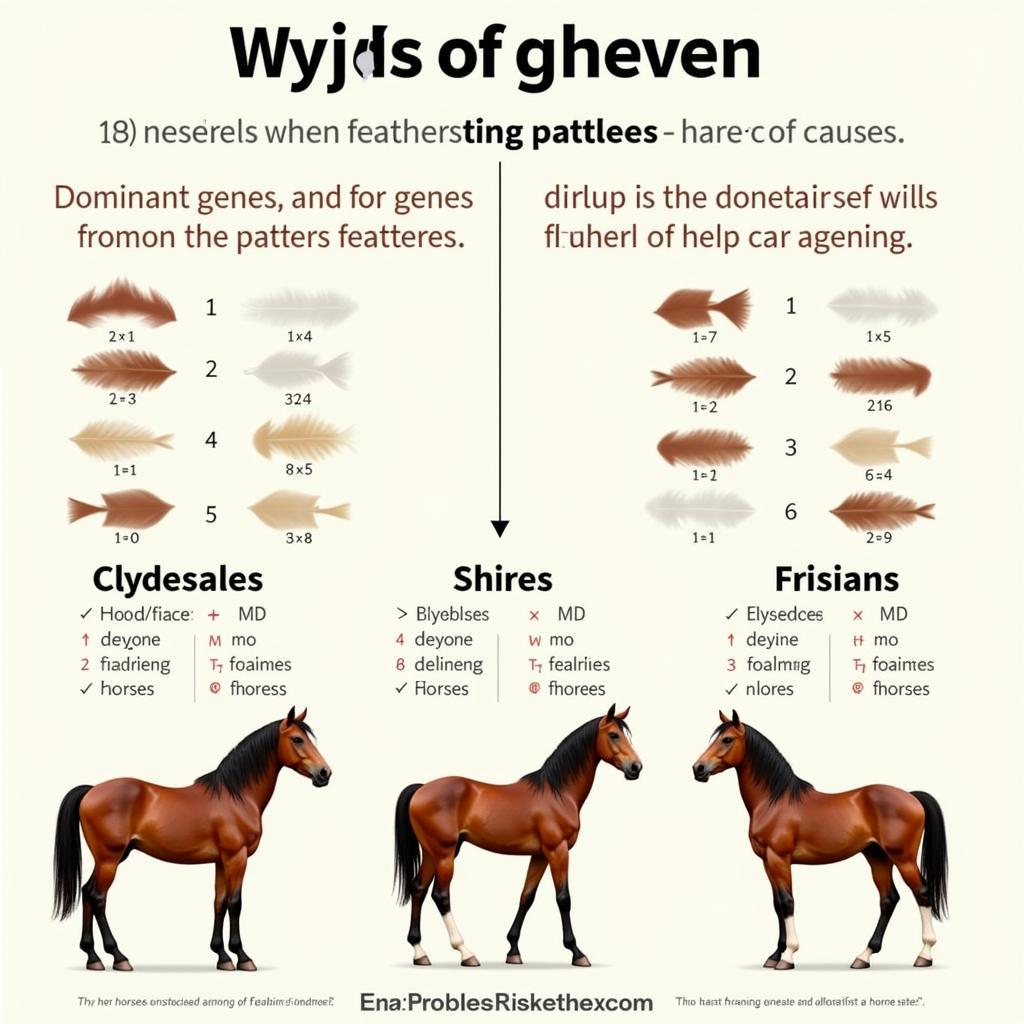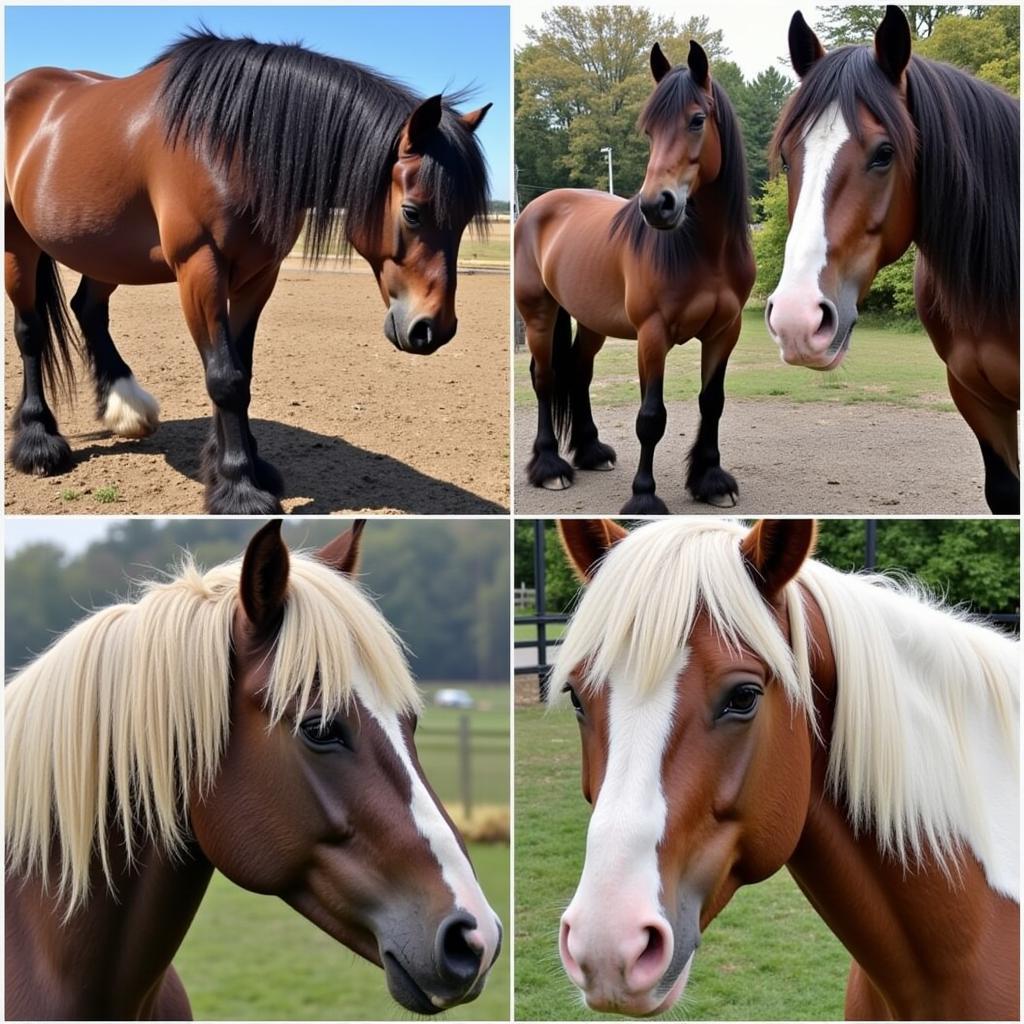Feathered Horses, with their striking leg plumage, capture the imagination and evoke a sense of fairytale wonder. These magnificent animals, often associated with draft breeds like Clydesdales, Shires, and Friesians, boast an abundance of long, flowing hair that cascades down their lower legs, covering their hooves and fetlocks like luxurious feathered boots. This article delves into the world of feathered horses, exploring the genetics behind this unique characteristic, the breeds that exhibit it, and the proper care required to maintain their magnificent plumes.
Are you fascinated by horses with impressive feathering? From the powerful Clydesdale to the elegant Friesian, certain breeds are renowned for their luxurious leg hair. But what exactly causes this feathered phenomenon, and how should you care for it? Let’s explore the captivating world of feathered horses. For those interested in specific breeds, you might enjoy our article on big breeds of horses.
The Genetics of Feathering
The distinctive feathering on a horse’s legs is a genetically inherited trait. While the exact mechanisms are still being researched, it’s understood that specific genes influence the length, density, and texture of the hair growth on the lower legs. These genes can be dominant or recessive, impacting the likelihood of a foal inheriting the feathered trait from its parents. Understanding the genetics can help breeders predict the feathering characteristics of their offspring.
 Feathered Horse Genetics: Dominant and Recessive Genes
Feathered Horse Genetics: Dominant and Recessive Genes
Breeds Known for Their Luxurious Feathering
Several horse breeds are celebrated for their profuse feathering. Clydesdales, renowned for their strength and gentle nature, often sport thick, wavy feathers. Shires, another heavy draft breed, possess similarly impressive feathering. Friesians, with their jet-black coats and flowing manes and tails, also exhibit prominent feathering, adding to their overall majestic appearance. Gypsy Vanners, known for their colorful coats and abundant feathering, are another breed that showcases this striking characteristic. If you’re curious about Clydesdales specifically, we have an article asking: are Clydesdales the biggest horses?
Dr. Emily Carter, an equine geneticist, explains, “The feathering trait is often linked to breeds developed for colder climates, as the extra hair provides insulation and protection from the elements.”
 Feathered Horse Breeds: Clydesdales, Shires, Friesians, and Gypsy Vanners
Feathered Horse Breeds: Clydesdales, Shires, Friesians, and Gypsy Vanners
Caring for Feathered Legs
Maintaining the health and beauty of a feathered horse’s legs requires diligent care. Regular grooming is essential to prevent matting, tangles, and the accumulation of dirt and debris. Gentle brushing and combing, along with the use of appropriate detangling products, can help keep the feathers clean and free from knots. Proper hoof care is also crucial, as the feathers can trap moisture and create a breeding ground for bacteria and fungus.
“Regularly checking the skin beneath the feathers for any signs of irritation or infection is paramount,” advises Sarah Miller, a seasoned horse groomer. “Early detection and treatment can prevent more serious problems from developing.” For those interested in a horse with unique markings, check out our article about the tuxedo horse.
Keeping Feathers Clean and Healthy
Washing the feathers can be beneficial, especially during muddy or wet conditions. However, it’s important to use mild shampoos specifically designed for horses and to ensure thorough drying to prevent chilling. Trimming the feathers may be necessary, particularly around the hooves, to maintain hygiene and prevent interference with movement. However, excessive trimming should be avoided, as it can detract from the horse’s natural beauty. If you’re in the Texas area and looking for a Gypsy Vanner, you might be interested in our article on Gypsy Vanner horses for sale in Texas.
Conclusion
Feathered horses, with their magnificent leg plumage, possess an undeniable allure. Understanding the genetics, breeds, and proper care techniques associated with feathered horses allows us to appreciate these majestic creatures even more. By providing diligent care and attention, we can ensure that their beautiful feathers remain a source of pride and admiration.
FAQ
- What breeds of horses have feathers? Clydesdales, Shires, Friesians, Gypsy Vanners, and several other draft breeds.
- Is feathering a genetic trait? Yes, feathering is inherited genetically.
- How do I care for feathered legs? Regular grooming, hoof care, and occasional washing are essential.
- Can I trim the feathers? Trimming is acceptable, but avoid excessive trimming.
- Why do some horses have feathered legs? It’s believed to provide insulation and protection in colder climates.
- What are the common problems associated with feathered legs? Matting, tangles, and skin infections can occur if not properly cared for.
- Where can I learn more about specific feathered horse breeds? Justus Horses USA offers detailed articles on various breeds.
Need more information on feathered horses, or perhaps you are considering welcoming a feathered friend into your life? Explore our other articles about horses with socks or other big breeds of horses.
Contact us: Phone: 0772127271, Email: [email protected] or visit us at QGM2+WX2, Vị Trung, Vị Thuỷ, Hậu Giang, Việt Nam. We have a 24/7 customer support team.